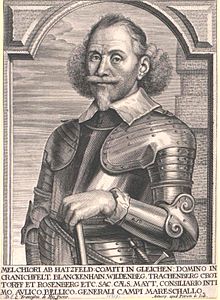Melchior von Hatzfeldt: Difference between revisions
Moonraker12 (talk | contribs) add category |
|||
| Line 4: | Line 4: | ||
== Biography == |
== Biography == |
||
He was the second of five sons of Sebastian von Hatzfeldt and Lucie von Sickingen. His younger brother was [[Franz von Hatzfeldt]], [[Bishopric of Würzburg]]. In 1620 he entered the imperial Army under Wallenstein, became Colonel in 1632, [[Feldmarschalleutnant]] in 1633 and Field Marshal in 1635. |
He was the second of five sons of Sebastian von Hatzfeldt and Lucie von Sickingen. His younger brother was [[Franz von Hatzfeldt]], [[Bishopric of Würzburg|Prince-Bishop of Würzburg]]. In 1620 he entered the imperial Army under Wallenstein, became Colonel in 1632, [[Feldmarschalleutnant]] in 1633 and Field Marshal in 1635. |
||
| ⚫ | After the murder of Wallenstein in February 1634, he entered in the service of [[Matthias Gallas]]. On 4 October 1636, he suffered a defeat in the [[Battle of Wittstock]] against the Swedes under [[Johan Banér]]. Two years later he was victorious in the [[Battle of Vlotho]] and again in 1641 at the [[Siege of Dorsten]]. On 6 March 1645 Hatzfeldt was taken prisoner by the Swedes during the [[Battle of Jankau]], but released shortly after. He retired in 1646, but was recalled to service in 1657 as [[Generalfeldmarschall]], to support the King of Poland at the head of an army of 16,000 men against [[Charles X Gustav of Sweden]]. He [[Siege of Kraków (1657)|took Kraków]] on August 30. |
||
After the murder of Wallenstein in February 1634, he entered in the service of [[Matthias Gallas]]. |
|||
| ⚫ | On 4 October 1636, he suffered a defeat in the [[Battle of Wittstock]] against the Swedes under |
||
He died a few months after his return home. His body was buried in [[Prusice|Prausnitz]], and his heart at [[Laudenbach (Weikersheim)]]. Both tombs were constructed by Achilles Kern (1607–1691). |
He died a few months after his return home. His body was buried in [[Prusice|Prausnitz]], and his heart at [[Laudenbach (Weikersheim)]]. Both tombs were constructed by Achilles Kern (1607–1691). |
||
Revision as of 15:16, 10 April 2021


Melchior Graf von Gleichen und Hatzfeldt (Westerwald, 20 October 1593 – Powitzko, 9 January 1658) was an Imperial Field Marshal, who fought in the Thirty Years' War under Albrecht von Wallenstein and Matthias Gallas.
Biography
He was the second of five sons of Sebastian von Hatzfeldt and Lucie von Sickingen. His younger brother was Franz von Hatzfeldt, Prince-Bishop of Würzburg. In 1620 he entered the imperial Army under Wallenstein, became Colonel in 1632, Feldmarschalleutnant in 1633 and Field Marshal in 1635.
After the murder of Wallenstein in February 1634, he entered in the service of Matthias Gallas. On 4 October 1636, he suffered a defeat in the Battle of Wittstock against the Swedes under Johan Banér. Two years later he was victorious in the Battle of Vlotho and again in 1641 at the Siege of Dorsten. On 6 March 1645 Hatzfeldt was taken prisoner by the Swedes during the Battle of Jankau, but released shortly after. He retired in 1646, but was recalled to service in 1657 as Generalfeldmarschall, to support the King of Poland at the head of an army of 16,000 men against Charles X Gustav of Sweden. He took Kraków on August 30.
He died a few months after his return home. His body was buried in Prausnitz, and his heart at Laudenbach (Weikersheim). Both tombs were constructed by Achilles Kern (1607–1691).
In fiction
He is the main character in 1635: The Wars for the Rhine by Anette Pedersen, part of Eric Flint's 1632 series.
External links
- Literature by and about Melchior von Hatzfeldt in the German National Library catalogue
Sources
This article includes a list of references, related reading, or external links, but its sources remain unclear because it lacks inline citations. (December 2016) |
